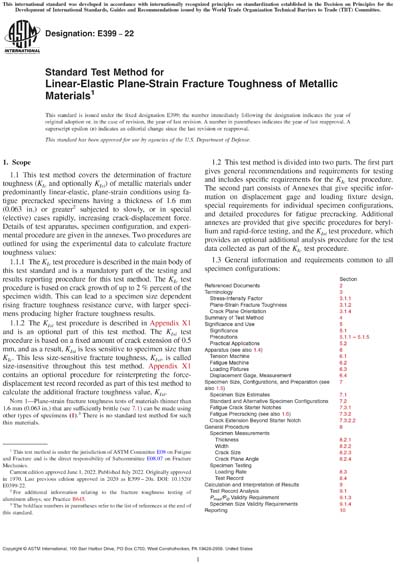Historical
ASTM E399-22
Standard Test Method for Linear-Elastic Plane-Strain Fracture Toughness of Metallic Materials
1.1This test method covers the determination of fracture toughness (KIc and optionally KIsi) of metallic materials under predominantly linear-elastic, plane-strain conditions using fatigue precracked specimens having a thickness of 1.6 mm (0.063 in.) or greater2 subjected to slowly, or in special (elective) cases rapidly, increasing crack-displacement force. Details of test apparatus, specimen configuration, and experimental procedure are given in the annexes. Two procedures are outlined for using the experimental data to calculate fracture toughness values:
1.1.1The KIc test procedure is described in the main body of this test standard and is a mandatory part of the testing and results reporting procedure for this test method. The KIc test procedure is based on crack growth of up to 2 % percent of the specimen width. This can lead to a specimen size dependent rising fracture toughness resistance curve, with larger specimens producing higher fracture toughness results.
1.1.2The KIsi test procedure is described in Appendix X1 and is an optional part of this test method. The KIsi test procedure is based on a fixed amount of crack extension of 0.5 mm, and as a result, KIsi is less sensitive to specimen size than KIc. This less size-sensitive fracture toughness, KIsi, is called size-insensitive throughout this test method. Appendix X1 contains an optional procedure for reinterpreting the force-displacement test record recorded as part of this test method to calculate the additional fracture toughness value, KIsi.
Note 1:Plane-strain fracture toughness tests of materials thinner than 1.6 mm (0.063 in.) that are sufficiently brittle (see 7.1) can be made using other types of specimens (1).3 There is no standard test method for such thin materials.
1.2This test method is divided into two parts. The first part gives general recommendations and requirements for testing and includes specific requirements for the KIc test procedure. The second part consists of Annexes that give specific information on displacement gage and loading fixture design, special requirements for individual specimen configurations, and detailed procedures for fatigue precracking. Additional annexes are provided that give specific procedures for beryllium and rapid-force testing, and the KIsi test procedure, which provides an optional additional analysis procedure for the test data collected as part of the KIc test procedure.
1.3General information and requirements common to all specimen configurations:
1.4Specific requirements related to test apparatus:
1.5Specific requirements related to individual specimen configurations:
1.6Specific requirements related to special test procedures:
1.7The values stated in SI units are to be regarded as the standard. The values given in parentheses are for information only.
1.8This standard does not purport to address all of the safety concerns, if any, associated with its use. It is the responsibility of the user of this standard to establish appropriate safety, health, and environmental practices and determine the applicability of regulatory limitations prior to use.
1.9This international standard was developed in accordance with internationally recognized principles on standardization established in the Decision on Principles for the Development of International Standards, Guides and Recommendations issued by the World Trade Organization Technical Barriers to Trade (TBT) Committee.
ASTM International [astm]

